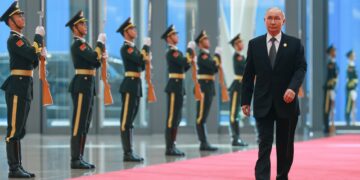August 12, 2025
Five key points for the Trump-Putin meeting in Alaska
FOR IMMEDIATE RELEASE:
August 12, 2025
Contact: press@defensepriorities.org
WASHINGTON, DC—On Friday, President Trump is scheduled to meet with Russian President Vladimir Putin in Alaska. Defense Priorities Director of Military Analysis Jennifer Kavanagh issued the following statement in response:
The upcoming Alaska summit holds both promise and peril for President Trump who has been vowing to bring the Ukraine-Russia war to an end since before he returned to the White House seven months ago.
Mr. Trump should keep five things in mind as he prepares to engage Russian President Vladimir Putin.
1. Mr. Trump does not need a grand bargain that resolves the war to declare the meeting a success. In fact, such an outcome is unlikely. Instead, Mr. Trump should think of this face-to-face with Mr. Putin as merely the start of the peacemaking process. If he leaves Alaska with a commitment from Mr. Putin to continue negotiating and a concrete plan in place for Washington, Moscow, and Kyiv to begin hashing out the terms of a ceasefire and eventual settlement, Mr. Trump will have done well.
2. Mr. Trump should not be fooled into thinking that land swaps alone will be sufficient to end this war. In recent days, both Mr. Trump and his envoy Steve Witkoff have focused heavily on territory as a condition for ceasefire, and though territorial considerations are not irrelevant, they are far from the most important concern for either combatant.
A range of other issues will also need to be addressed to achieve an end to the fighting, including the size and shape of Ukraine’s future military, the status of Ukraine’s potential membership in NATO, and even the broader European security architecture. Clearly not all of these issues will be covered in depth on Friday, but if Mr. Trump intends to use this meeting to “feel Putin out” then he should be sure to gauge Mr. Putin’s redlines and openness to compromise in these areas as well.
3. Mr. Trump should not overestimate his leverage. He is in a good negotiating position, but there are limits to how far he can push Mr. Putin or Ukrainian President Volodymyr Zelensky. Economic punishments and threats of more military aid for Ukraine have failed to move Mr. Putin and they will continue to do so, especially as Russia begins to make breakthrough gains on the Ukrainian battlefield. Instead, Mr. Trump’s greatest advantage over Russia is that Mr. Putin needs U.S. engagement to achieve some of his war aims. In other words, walking away from negotiations is Mr. Trump’s strongest coercive move.
Mr. Trump has more influence over Mr. Zelensky, particularly if Ukraine’s frontlines in Donetsk begin to crumble. Mr. Trump should not be afraid to pressure Ukraine to accept concessions as part of a settlement, but he should ensure they are ones that he can actually impose. For example, asking Ukraine to give up territory it currently controls will be much harder than freezing territorial boundaries at the current line of contact.
4. Mr. Trump should not let spoilers talk him out of making difficult but necessary compromises to end the war. European states have already tried to rewind the clock with maximalist proposals that the Trump administration has long since ruled out, including NATO membership for Ukraine. They will likely try to do so again on Wednesday during the “emergency meeting” they have called with Mr. Trump and Mr. Zelensky. Mr. Trump should ignore these voices. Such maximalist demands amount to little more than a recipe for endless war and do not advance U.S. interests.
5. Most important, Mr. Trump should not be afraid to walk away from the bargaining table. The United States has few interests at stake in Ukraine and can cut its involvement entirely (in the fighting and the peacemaking) with no harm to U.S. national security if it becomes clear that Mr. Trump’s best efforts cannot make even incremental progress. Walking away would be a pragmatic choice to conserve U.S. resources for higher priorities. For the United States, a bad deal over Ukraine—one that leaves the United States with long-term commitments—is infinitely worse than no deal at all.
More on Ukraine-Russia

By Geoff LaMear
October 11, 2025
Featuring Daniel Davis
September 15, 2025

Featuring Jennifer Kavanagh
September 11, 2025
Events on Ukraine-Russia






